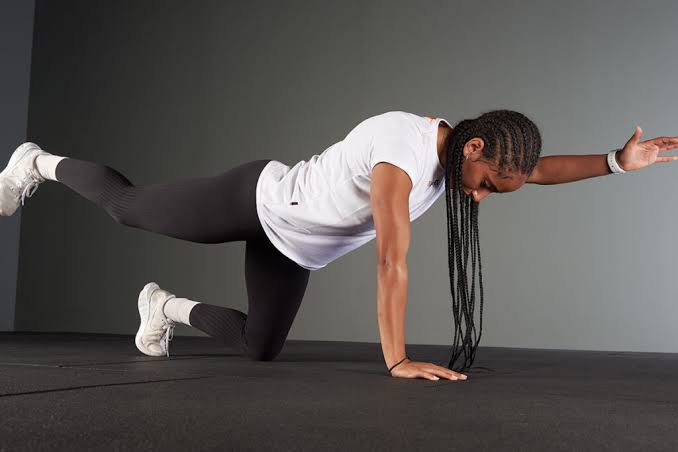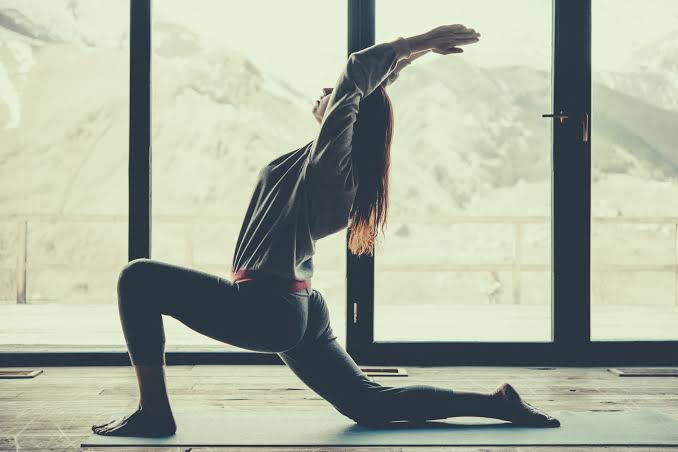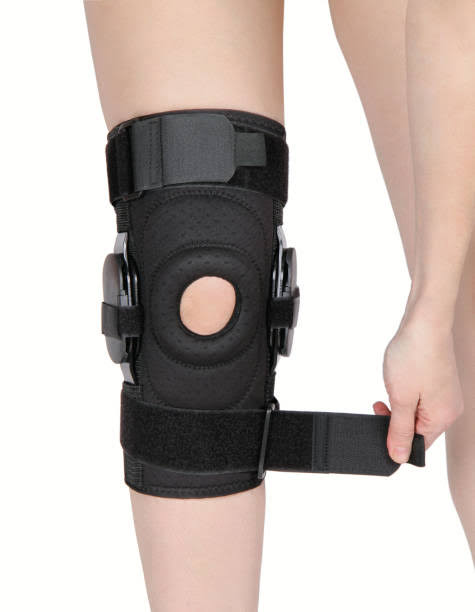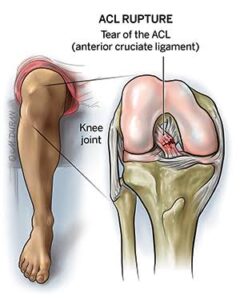ACL Injuries: Causes, Prevention, and Treatment
Learn about ACL injuries, including causes, prevention strategies, treatment options, and rehabilitation techniques to reduce the risk of Anterior Cruciate Ligament damage.

ACL Injuries: Understand the risks, symptoms, and rehabilitation options for Anterior Cruciate Ligament
ACL stands for Anterior Cruciate Ligament.
The Anterior Cruciate Ligament (ACL) joins the thigh and shin bones in the knee joint.
It plays an important function in:
- Supporting the knee joint
- Supporting rotational movements of the knee.
- Avoiding excessive forward movement of the tibia.
- Encouraging smooth movement and flexibility

The ACL is positioned in the center of the knee joint, connecting the femur to the tibia. The knee’s four primary ligaments are:
- Posterior cruciate ligament (PCL)
- Medial collateral ligament (MCL)
- Lateral collateral ligament (LCL)
For more, read: VICTOR OSIMHEN SILENCES POSTECOGLOU: NIGERIAN STRIKER’S BRACE LEADS GALATASARAY TO THRILLING 3-2 VICTORY OVER TOTTENHAM
Functions: The ACL serves numerous crucial:
- Stability: Provides anterior (forward) stability for the knee joint.
- Proprioception: Regulates movement and position sense.
- Movement: Promotes flexion (bending), extension (straightening), and rotation.
ACL injuries can greatly affect
- Daily activities,
- Sports performance, and
- Quality of life.
Tears or ruptures may cause:

- Knee instability.
- Pain
- Swelling.
- Limited Mobility
- Increased risk of future injuries or degenerative disorders (e.g., osteoarthritis).
Causes of ACL Injuries
The Anterior Cruciate Ligament (ACL) is one of the most commonly injured ligaments in the knee.
For more, read: Best Ways Of Achieving UEFA Coaching Badges As An African 2025
Common causes of ACL injuries include:
- Sudden stops or changes in direction: Quick deceleration or sharp turns can put excessive stress on the ACL. Examples: Football, soccer, basketball, tennis, and other sports requiring rapid changes of direction.
- Landing from jumps incorrectly: Poor landing techniques include landing with straight or locked knees, not rolling with the fall, and failing to absorb shock through hip and knee flexion. Examples include basketball, volleyball, gymnastics, and other jumping sports.
- Direct blows to the knee: Traumatic hits include tackles, collisions in contact sports, and falls against the knee. Car accidents can occur during contact sports such as football, hockey, and soccer.
- Twisting or pivoting movements: Sports that require quick direction changes, such as soccer, basketball, and tennis, can cause rotational stress on the ACL.
- Overuse or repetitive strain: ACL wear and tear can result from repetitive jumping or landing, continuous running or cutting, and insufficient recovery time. Examples include long-distance running, cycling, and endurance sports.
- Weak core and leg muscles: Inadequate strength and stability in core and leg muscles can cause inefficient movement patterns and higher ACL stress.
- Poor landing techniques: Incorrect landing mechanics can occur in sports like basketball, volleyball, and gymnastics. Examples include not keeping the knee in line with the toes, not using hip and knee flexion to absorb impact, and landing with too much forward lean.
- Sports-related injuries (e.g., football, basketball, soccer).
A breakdown of the eight common causes of anterior cruciate ligament (ACL) injuries in sports:
- Football
—Typical mechanics include tackling, being tackled, and landing from jumps.
For more, read: eguavoens-super-eagles-squad-for-libya-clash-raises-eyebrows-iheanacho-chukwueze-awoniyi-omissions-spark-debate
—At-risk positions include running backs, wide receivers, linebackers, and defensive bac
–Injury rate: 0.24-0.45 per 1000 athlete exposures.
- Basketball
– Common processes include landing after jumps, rapid stops, or direction changes.
– Positions at risk: centers, forwards, and guards.
– The injury rate is 0.19-0.39 per 1,000 athlete exposures.
- Soccer
– Common processes include twisting or pivoting movements, jump landings, and collisions.
– At-risk positions include midfielders, forwards, and defenders.
– The injury rate is 0.17-0.35 per 1,000 athlete exposures.
Prevention of ACL Injuries
A multifaceted approach is necessary to prevent ACL damage.
Here’s a thorough description of each preventative strategy:
1. Strengthening the core and leg muscles: Exercises: squats, lunges, deadlifts, leg press, leg curls, and calf raises.

Benefits:
– Improves knee stability – Increases muscle balance – Lowers ACL stress
2. Increasing flexibility and range of motion: Stretching your hamstrings and quadriceps, hip flexors, and calves can improve flexibility and reduce muscular imbalances.
Improves movement efficiency.

3. Improving proprioception (awareness of body position)
- Exercises include balance training, such as single-leg squats and balancing boards.
- Plyometric training (such as jump squats and box jumps)
- Agility drills (such as cone drills and ladder drills)
Benefits:
- Improves body awareness
- Increases movement control
- Lowers the likelihood of ACL injury
4. Practice Proper Landing Techniques
- Key features are knee bend and absorption, hip and knee flexion, ankle stability, and soft landings.
Benefits:
- Reduces ACL stress, improves jump landing form, and lowers injury risk.
5. Wearing appropriate footwear and equipment.
Considerations:
- Supportive shoes.
- Orthotics or arch support
- Knee sleeves or braces (recommended)

–
Benefits:
- Offers stability and support
- Lowers injury risk – Improves performance.
6. Participating in injury prevention programs.
Examples include:
- ACL prevention procedures, such as FIFA 11+.
- Sports-specific training programs.
- Injury prevention clinics.
Benefits:
- Reduces ACL injury risk – Enhances overall athleticism
- Improves team performance.
7. Avoiding Overtraining and Fatigue.
Strategies:
- Gradual training progression.
- Allow enough healing time
- Pay attention to your body’s signal
Benefits include reduced injury risk, improved performance, and improved general well-being.
8. Including plyometric and agility training.

– Exercises include jump squats, box jumps, cone drills, and ladder exercises.
Benefits:
- Boosts power and explosiveness – Increases agility and speed – Lowers the risk of ACL injury
- By implementing these prevention measures into your training regimen, you can drastically lower your chance of ACL damage.
Cure/treatment for ACL injuries
Treatment for ACL injuries often includes:
Non-surgical treatment options include
- physical therapy to strengthen surrounding muscles.
- Braces or knee supports
- Medication-based pain management
- Rest, Ice, Compression, and Elevation (RICE) Protocol
Surgical options:
- ACL reconstruction surgery.
- Grafting (using tissue from a different section of the body)
- Rehabilitation and physical therapy after surgery.
Diagnosis of ACL injuries.
Diagnosing ACL damage usually involves:
- Medical history and physical assessment.
- Imaging testing (such as X-rays and MRI)
- The Lachman test (knee stability assessment)
- The pivot shift test (knee stability evaluation)
- Anterior drawer test (assessing knee stability)
ACL injuries are more common in women.
Women are 2-8 times more likely to sustain an ACL injury because of:
Anatomical Differences:
- Wider pelvis and larger Q-angle (knee alignment)
- Smaller ACL size – Reduced muscle mass and strength.
biomechanical differences:
- Landing techniques: Women often land with straighter knees and less hip flexion.
- Movement patterns: Women frequently demonstrate more valgus (inward) knee movement.
- Hormonal Influences: Fluctuations in estrogen levels may influence ligament strength.
ACL Reconstruction Surgery Success Rate
The success rate for ACL reconstruction surgery is high.
- 90–95 percent of patients return to sports and activities.
- Between 85 and 90% of patients report considerable improvement in knee function.
- 75–80% of patients achieve full knee stability.
Rehabilitation After ACL Surgery
Rehabilitation usually lasts 6-9 months and includes:
- Immediate post-operative (0-2 weeks): Pain treatment, edema reduction, and knee mobility.
- Early rehabilitation (2-6 weeks): Strengthening surrounding muscles and enhancing range of motion
- Intermediate rehabilitation (6–12 weeks): progressive strengthening, agility training, and plyometrics
- Advanced recovery (3-6 months): Sports-specific training and return to activities
- Maintenance phase (6-9 months): Continuous strengthening, flexibility, and injury prevention.
Preventive Measures Reduce ACL Injury Risk
Studies reveal that preventive interventions can reduce the chance of ACL injury by up to 70%.
- Neuromuscular training programs (such as FIFA 11+)
- Building core and leg muscles
- Increasing flexibility and range of motion.
- Improving proprioception and motor control
- Practice proper landing techniques.
Examples of successful preventative programs:
- FIFA 11+
- ACL Prevention Protocol(APP)
Sports-specific training programs (e.g., soccer and basketball)
Individuals who recognize these characteristics and take preventive measures can dramatically lower their risk of ACL injury.





